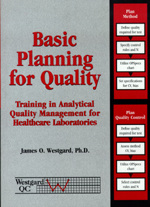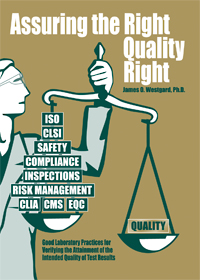Basic Planning for Quality
QP 4: Devising a Practical Process
Ok, so we agree that we need to plan quality. But how to do it? Isn't it incredibly complex and consuming and therefore we simply don't have time for it? NO! There's an easy way to plan quality, a step-by-step process that we can use for every test in the lab. Read this to discover it. (Preview)
- Review your intended applications
- Recognize two categories of applications
- Identify a practical quality-planning tool
- Adapt the CLSI QC planning tool
- Define a detailed step-by-step process
- Obtain the necessary tools or technology
- References
The importance of implementing a quality-planning process is evident from the general principles of Total Quality Management (TQM) as embodied in the accreditation requirements of JCAHO's IOP standards [1]. CLIA provides a focus on laboratory testing processes and provides specific rules for validating the performance of methods and planning QC procedures [2]. NCCLS addresses the issue of how to perform quality-planning for QC procedures in general terms [3]. However, none of these describe a detailed process that can easily be implemented. Our objective in this lesson is to devise a detailed step-by-step process that can be supported by available tools or technology.
Review your intended applications
An understanding of your own uses of a quality-planning process is important, particularly for assessing the practicality of different tools and technology. If you are a laboratory quality coordinator, your first interest may be in satisfying regulatory and accreditation guidelines for planning your testing processes. A rigorous and well-documented process will be important. If you are a manufacturer, your interest may be in establishing performance specifications for the precision and accuracy of new methods. If you are a laboratory inspector or a technical field specialist for a manufacturer, you may be visiting different laboratories and will need a "portable" process that you can take with you - most likely installed on your computer.
- Laboratory applications. Selecting control rules and numbers of control measurements is, of course, an important application in a service laboratory. In addition, the performance needed by the method can also be determined if the QC procedures are given, which should be useful in establishing purchase specifications for methods, instruments, and systems. QC recommendations from manufacturers and QC guidelines given in the literature can be evaluated to be sure they are adequate for the quality required for the test and the analytical performance claimed for the method. It is also possible to compare allowable total errors, clinical decision intervals, and biologic goals to determine which is most demanding and should take priority in managing a testing process.
- Manufacturers' applications. The design of new methods and systems should be greatly aided by a quantitative approach for setting performance specifications for imprecision and inaccuracy. QC recommendations can objectively developed and validated based on regulatory quality requirements, the design specifications for imprecision and inaccuracy, and the common QC practices in the marketplace. Customers can be supported and assisted in the proper management of analytical systems by having a better understanding of the relationships between the quality required for a test, the imprecision and inaccuracy expected from a method, and the QC procedures to be implemented.
- Regulatory and accreditation applications. It is interesting that there is little documentation of the source and origin of proficiency testing (PT) criteria, such as those allowable total errors specified by CLIA. Regulatory agencies and PT providers should evaluate the practicality of proposed PT criteria by comparison with clinical decision intervals, taking into account the common QC practices and expected method performance. Manufacturer's QC product labeling should be reviewed to assess whether those QC instructions are valid for the intended users. Laboratory QC practices should be reviewed to assess whether they are valid to assure the quality needed for the patient populations and clinical applications of a healthcare organization. Laboratorians and manufacturer's should be educated and supported to provide more optimal management of the analytical quality of their tests and systems.

 We invite you to read the rest of this article
We invite you to read the rest of this article
Note: This material is covered in the Basic Planning for Quality manual, which is availalbe in our online store. You can download the Table of Contents and additional chapters here.
Updated and expanded coverage of these topics can be found in Assuring the Right Quality Right,also available in our online store. You can also download the Table of Contents and additional chapters here.
Finally, you can access materials online on these topics by enrolling in the Management and Design of Analytical Quality Systems course course.
